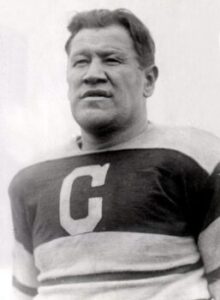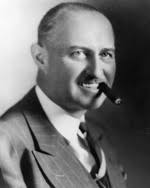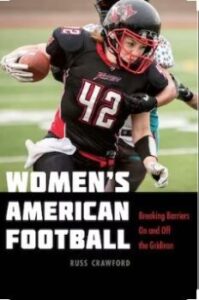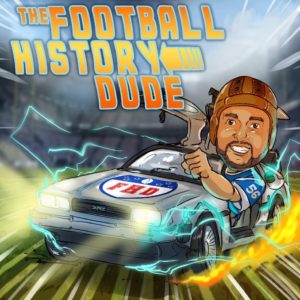In this episode, we fire up the DeLorean and head back to explore the life and career of Ralph Hay, The Founder of the NFL. He was an owner of an auto dealership and the Canton Bulldogs, a professional football team. Professional football in the Ohio region was on the brink of extinction, so Mr. Hay gathered together representatives from 11 different teams on September 17, 1920, to discuss the formation of a new league.
The meeting would result in the formation of the American Professional Football Association, which would later become the NFL. So strap on your seat belt, and let’s get ready to take this baby up to 88mph.
In the year 1920, professional football was at a crossroads. The league could have easily fallen into the depths of obscurity, or it could rise to a level of greatness. An automobile showroom in Canton, OH would serve as the backdrop for this pivotal moment, and buckets of beer all over the showroom would serve as the liquid refreshment that would help decide the fate of the NFL.
RALPH HAY'S BACKGROUND
When we step off our time machine in this episode, we end up in Canton, OH. Yes, this is the home of the Pro Football Hall of Fame, but it wasn’t around in the year of our landing. The day is January 12, 1891. We’re here to look at our hero of the episode, Ralph E. Hay.
We landed on the day he was born, and we’re in the city he lived in and ended up founding what would ultimately be known as the National Football League. Ralph would end up working at a car dealership after graduating high school. Soon he found he had a knack for selling cars, which probably can at least partially explain why he was able to sell the rest of the teams in the area to form a new league.

After a few years of selling cars, Ralph decided to open his own dealership, called Ralph E. Hay Motor Company. His dealership would sell Hupmobiles, Jordans, and Pierce-Arrows. Hupmobiles seemed to me more like working-man-class vehicles. They were a little more affordable and not so flashy compared to the rest. A Pierce-Arrow was a luxurious car that exuded classiness. Many famous people of the time were known to have Pierce-Arrows in their collections.
Some of the names more recognizable to me included John D. Rockefeller, Orville Wright, J. Edgar Hoover, and Babe Ruth. Another cool note about the Pierce-Arrow car is 1909 President Howard Taft requested the vehicles become the official car of the White House.
To me, the more interesting vehicle sold at the Ralph E. Hay Motor Company was the Jordan’s. The company was said to be the first to give more exotic names to the cars. A few examples include Sports Marine, Tomboy, and Playboy. The Playboy had an ad that many marketers claim was the turning point in the automotive industry advertising game.
It was a picture of a cool-looking dude riding in a Jordan Playboy, with a cowboy on a horse chasing him. What was more intriguing was the ad copy that was posted with the picture. This was meant to get the blood pumping for guys who would read the ad to make them want to immediately go to the dealership to purchase one. The ad went as such:
“Somewhere west of Laramie, there is a bronco-busting, steer-roping girl who knows what I’m talking about. She can tell what a sassy pony, that a cross between greased lightning and the place where it hits, can do with eleven hundred pounds of steel and action when he’s going high, wide, and handsome. The truth is the Jordan Playboy was meant for her.”
Hay would ultimately build his dealership to the largest in the area, and he would end up presenting an amphibious hydro-car to Congress in 1917 for use in the war.

RALPH HAY AND THE CANTON BULLDOGS
In what originally may have been more of a savvy marketing move to promote the car dealership, Ralph Hay purchased the Canton Bulldogs in 1918. The team was one of the more prominent and dominant teams of the time. From 1915 to 1923, the team amassed a record of 47-1-5, while also winning five championships.
Three of these championships occurred under the ownership of Hay. A record of most games without a loss happened from 1921 to 1923. The team went 22-0-3 in 25 consecutive games. This still stands as an NFL record. Ralph Hay would end up selling the team in 1923.

THE BEGINNING OF SOMETHING SPECIAL
Football was continuing to gain popularity by the year 1920, especially in the college arena. However, the professional game was on the verge of possibly collapsing, especially in the Ohio area. Player salaries were rising, and they were often jumping teams from game to game. This led to teams worrying about going broke as a joke.
Something had to be done to create some sort of continuity and organization for the teams. Ralph Hay was the man for the job. He kicked off the original investigation into forming a new league by hosting an initial meeting with representatives from 3 other teams in his office at the dealership.
AUGUST 20, 1920 MEETING
The date was August 20, 1920. Ralph had a ringer of his own that went by the name Jim Thorpe. Also referred to as “Big Jim,” Mr. Thorpe was one of the most recognizable athletes in the world. From Akron came Frank Nied (a cigar store proprietor) and Art Ranney (another Rubber City businessman.) Cleveland Tiger manager Jimmy O’Donnell brought Stanley Cofall, a star player and coach of his team.
The year prior it was said O’Donnell and Hay had some beef because Hay refused to put the Tigers on the schedule for the Bulldogs. O’Donnell was upset because he needed Jim Thorpe to draw the crowd. The final attendee was the owner/manager of the Dayton Triangles, Carl Storck.
The meeting notes were vague and short, but one of the notable results of the meeting as it would be the first time the group would call themselves the American Professional Football Conference. They also elected Ralph Hay as the temporary secretary and party responsible for inviting and hosting the other major teams in the area.
To sort of “cover-up” the meeting, there was a discussion of hammering out the schedule, to keep the meeting sort of low-key. However, various newspaper outlets elaborated on the details a little more, but the accuracy could be left to the imagination.
A couple of articles from the Canton Repository went as such:
“The purpose of the A.P.F.C will be to raise the standard of professional football in every way possible, to eliminate bidding for players between rival clubs and to secure cooperation in the formation of schedules, at least for the bigger teams.”
“Members of the organization reached an agreement to refrain from inducements to players to jump from one team to another, which has been one of the glaring drawbacks of the game in past seasons. Contracts must be respected by players as far as possible, as well as by club managers.”
An article from the Dayton Journal Herald went as such:
“The league voted unanimously not to seek the services of any undergraduate player. Last season there were quite a number of intercollegiate stars who padded their bankrolls by slipping away on a Sunday and performing with a pro team, using every name under the sun but their own to hide their own identity. Some startling disclosures came later that brought the wrath of intercollegiate heads down on the pro game.”
It could be understood why they would say the wrath was brought down by intercollegiate heads because, at the time, college football was more dominant and powerful than professional teams. A topic also described as murky was the talk about capping player salaries. As stated, meeting notes were also murky and not very detailed.
THE OFFICIAL MEETING (SEPTEMBER 17, 1920)
After we discussed the preliminary meeting on August 20, 1920, we hopped back on my DeLorean to go about a month into the future. The new landing date is September 17, 1920. This is the day when Ralph Hay was able to gather 11 teams to a meeting in his dealership showroom to form what would end up becoming the National Football League.
However, at the time the meeting was overshadowed by the signing of a monster All-American tackle by the Canton Bulldogs, Ralph’s team. I wonder if Ralph had any idea this signing would play 2nd fiddle to the meeting in the long run.
Now to the night of the meeting. By all accounts, it was a steamy hot night. Representatives from 11 teams were present at the meeting. The teams were Canton Bulldogs, Decatur Staleys, Chicago Cardinals, Akron Pros, Cleveland Indians, Dayton Triangles, Massillon Tigers, Hammond Pros, Muncie Flyers, Rock Island Independents, and Rochester Jeffersons.
Art Ranney took meeting notes, and again, the notes left much to the imagination. The meeting was officially called to order at 8:15 pm. However, the beer was free, so the attendees had been at the meeting before this time. There were more than likely many details hammered out before the meeting was actually called to order.
One of the results of the meeting was the name was changed from the American Professional Football Conference to the American Professional Football Association. It was suggested by many of the members that Ralph Hay would become the President of the newly formed association. Ralph was a smart individual, so he reminded the group he didn’t have any clout with the public eye.

However, there was a man in the room who was perfect for the job. Jim Thorpe was a former decathlon and pentathlon gold medalist in the 1912 Stockholm Olympics. He was one of the more recognizable people in the country, so the fit seemed perfect. The only issue that would come about would be Jim was proven to be a much better athlete than an administrator, so I believe many of the decisions were really made behind the scenes.
Stanley Cofall was named the Vice President. Art Ranney was selected as Secretary-Treasurer. Dr. Young was appointed as chairman. A trio of Flanigan, Storck, and Cofall would form a committee designated to draft the constitution and by-laws of the newly formed association. One of the agreements was all teams would have to announce their rosters on the first day of the new season.
This is no different than today’s NFL where teams must cut to the 53-man roster by a selected date. Another agreement was all teams would have to acquire official stationery with “Member of American Professional Football Association” at the top.
Mr. Marshall of the Brunswick-Balke Collender Company, Tire Division, presented a silver loving cup for the team that was “awarded the championship by the association.” This was significant because it pointed out how the champion was voted for instead of one through a playoff scenario.
Three of the major unsolved problems that still existed after the meeting were rising salaries, players jumping teams, and the use of college players. Due to the vagueness of the meeting minutes, it’s hard to decipher what was truly covered in the meeting and what was left out.

WHAT ALMOST WASN'T
At the end of the episode, I describe to you how the buckets of beer in the showroom could have possibly helped Hay win over the attendees at the association to come to an agreement. However, the same buckets of beer could have led to the demise of the future NFL. Prohibition was in full effect in the nation by the time this meeting was occurring.
The 18th Amendment made the sale and consumption of alcohol illegal. Therefore, if a police officer had seen the beer flowing at this meeting, it very well could have been shut down. This possibly could have halted talks about creating the association, and then it would be possible the NFL would never have existed.
Why is Ralph Hay Considered the Founder of the NFL?
In this episode, we fire up the DeLorean and head...
Read MoreThe Making of Women’s American Football: Breaking Barriers On and Off the Field
This week Russ Crawford, Professor of History at Ohio Northern...
Read MoreThe Quarterback Project: Do You Agree With Michael Mertes and His Top QB’s?
This week I spoke with Michael Mertes about a project...
Read MoreSpies on the Sidelines: How Much of an Impact Does Spying Have in the NFL?
While the phrase “three-letter agency” is a euphemism for American...
Read More



1 thought on “Why is Ralph Hay Considered the Founder of the NFL?”